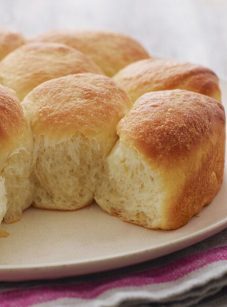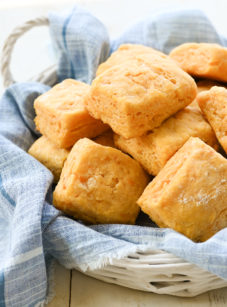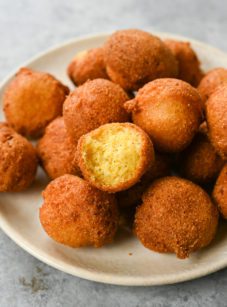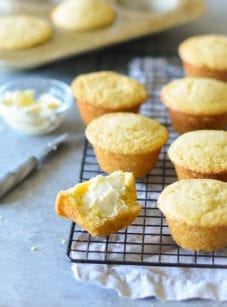Flaky Buttermilk Biscuits
- By Jennifer Segal
- Updated March 5, 2025
- 429 Comments
- Leave a Review


This post may contain affiliate links. Read my full disclosure policy.
Learn how to make the best homemade buttermilk biscuits—tender, flaky, and golden brown, they come together quickly with simple ingredients and an easy technique.

Classic Southern buttermilk biscuits are prized for their light, melt-in-your-mouth texture, typically made with White Lily flour, a soft wheat variety loved by biscuit bakers. Since it’s not always easy to find outside the South, I use a simple mix of all-purpose flour and cornstarch to achieve the same delicate crumb.
These buttermilk biscuits bake up golden and crisp on the outside, soft and buttery on the inside—and they’re ready in just 30 minutes from start to finish. Instead of using a biscuit cutter, I cut them into easy squares, which eliminates scraps and extra steps. Whether shaped into squares or rounds, they’re foolproof, delicious, and perfect with everything from honey butter to hearty gravy.
For an even easier alternative, try my drop biscuits or Cheddar Bay Biscuits—both skip the rolling and cutting altogether. Just drop, bake, and enjoy!
“These are amazing. Came together quickly for breakfast. My husband took a bite and gave me a high five. They’ll be a staple around here.”
What You’ll Need To Make Homemade Buttermilk Biscuits

- All-purpose flour: Provides the structure for the biscuits; always use the spoon-and-level method when measuring to ensure accuracy.
- Cornstarch: Softens the dough’s proteins to produce a more tender biscuit.
- Baking powder and baking soda: Leavening agents that work together to create rise and fluffiness in the biscuits. Baking soda also reacts with the acid in buttermilk, aiding in leavening and improving color.
- Sugar: Adds a slight sweetness to balance the flavors and aids in browning.
- Cold butter: Provides fat which, when cut into the dry ingredients, creates flaky layers as it melts and steams during baking. The cold temperature is crucial for achieving the desired flakiness, so keep it in the fridge until you’re ready to use it.
- Buttermilk: Moistens the dough and also adds acidity that reacts with the baking soda for leavening. If you don’t want to buy a whole carton, see my instructions for how to make buttermilk using milk and lemon juice or vinegar.
- Jump to the printable recipe for precise measurements
Step-by-Step Instructions
Step 1: Mix the dry ingredients and butter. Combine the flour, cornstarch, baking powder, baking soda, sugar, and salt in a food processor and pulse briefly to combine. Add the cold chunks of butter and pulse until the mixture resembles coarse sand with a few pea-size clumps of butter intact.

Step 2: Add the buttermilk. Transfer the mixture to a bowl. Add the buttermilk and stir until the mixture comes together into a shaggy mass. Be careful not to overmix — overmixing can impact the tenderness and rise of the finished biscuits.


Step 3: Layer the dough for flakiness. Turn the dough out onto a lightly floured work surface, shape it into a loose ball, and then gently pat it into a rectangle about 3/4-inch thick. Cut the dough in thirds. Stack the pieces on top of one another and then pat it out into a rectangle about 3/4-inch thick again.




Step 4: Continue layering and cut into squares. Again, cut the dough into thirds and stack the pieces. Finally, pat the dough into a rectangle with a thickness of about 3/4-inch. This repetitive process creates layers in the dough, which makes for deliciously flaky biscuits. Cut the dough into 12 small squares (these biscuits are on the smaller side, so feel free to cut into 9 squares if you prefer larger biscuits). At this point, the unbaked biscuits can be frozen for up to 3 months.




Step 5: Bake the biscuits. Space them evenly apart on a parchment-lined baking sheet and bake for 13 to 15 minutes, until golden.


The biscuits are best served warm out of the oven (though a few minutes in the oven will revive slightly stale biscuits). If you’d like to freeze leftovers, let them cool completely, wrap tightly in plastic wrap, and freeze in an airtight container—when ready to eat, simply reheat in the oven until warmed through (no need to thaw them first).

What to Serve with Buttermilk Biscuits
Buttermilk biscuits are incredibly versatile, pairing perfectly with sweet and savory dishes alike. Whether you’re serving them for breakfast, dinner, or as a side, here are some delicious ways to enjoy them:
For Breakfast:
- Classic with Butter & Jam – Keep it simple with softened butter and your favorite jam, honey, or apple or pumpkin butter.
- Sausage Gravy – A Southern favorite, smothered biscuits with creamy sausage gravy make for the ultimate comfort breakfast.
- Eggs & Bacon – Serve biscuits alongside scrambled eggs, an omelette, crispy oven-fried bacon, or even as a sandwich with eggs and cheese.
For Dinner:
- Fried Chicken & Biscuits – A true Southern classic! Pair with crispy buttermilk fried chicken tenders for a comforting meal.
- Soup or Stew – Use biscuits to soak up hearty dishes like beef stew, gumbo, or chicken noodle soup.
- BBQ: Biscuits make a great side for pulled pork, baby back ribs, or smoked brisket – Biscuits make a great side for smoky barbecue meats, or even as a base for mini pulled pork sliders.
Video Tutorial
More Bread Basket Recipes You May Like
Buttermilk Biscuits

Bring a touch of Southern charm to your table with this buttermilk biscuit recipe. They’re impossibly buttery, flaky, and easier to make than you’d think!
Ingredients
- 2 cups all purpose flour, spooned into measuring cup and leveled-off
- 3 tablespoons cornstarch
- 1 tablespoon baking powder
- ¼ teaspoon baking soda
- 1 tablespoon sugar
- 1¼ teaspoons salt
- 10 tablespoons cold unsalted butter, cut into ½-inch chunks
- ¾ cup buttermilk, plus a bit more if necessary (see note)
Instructions
- Preheat the oven to 425ºF and set an oven rack in the middle position. Line a 13x18-inch baking sheet with parchment paper.
- In the bowl of a food processor, combine the flour, cornstarch, baking powder, baking soda, sugar and salt. Pulse a few times to mix. (Alternatively, combine the ingredients in a mixing bowl.)
- Add the butter and pulse until the mixture resembles coarse sand with a few pea-sized clumps of butter intact. (If making by hand, "cut" the butter into the dry ingredients with a pastry cutter, two knifes, or your fingertips.) Transfer the mixture to a mixing bowl.
- Add the buttermilk and stir with a spoon or rubber spatula until the dough comes together into a shaggy mass. If the dough seems too dry, add a few more tablespoons of buttermilk. Do not over-mix.
- Turn the dough out onto a lightly floured work surface. Dust the top of the dough with a bit more flour and bring together gently into a loose ball. Pat the dough into a rectangle about ¾ inch thick.
- Using a sharp knife, cut the dough into thirds. Stack the pieces on top of one another and pat out into a rectangle about ¾ in thick again, flouring the surface lightly as needed to prevent the dough from sticking.
- Cut the dough into thirds again. Stack the pieces on top of one another and pat into a rectangle with a final thickness of about ¾ inch.
- Dust the blade of a sharp knife with flour and cut the dough into twelve even squares (they will seem small). Transfer the squares to the prepared baking sheet and bake for 13 to 15 minutes, until the biscuits are lightly golden on top and a rich, golden brown on the bottom. The biscuits are best served warm out of the oven (though a few minutes in the oven will revive slightly older biscuits).
- Note: If you’d like to make your own buttermilk, see my instructions for how to make buttermilk.
- Freezer-Friendly Instructions: Before baking, the biscuits can be frozen for up to three months. Place the unbaked biscuits on a baking sheet and freeze until solid, then transfer them to a freezer-safe bag or container. When ready to bake, there's no need to thaw but they may require a few extra minutes in the oven.
Nutrition Information
Powered by ![]()
- Serving size: 1 biscuit
- Calories: 179
- Fat: 10g
- Saturated fat: 6g
- Carbohydrates: 20g
- Sugar: 2g
- Fiber: 1g
- Protein: 3g
- Sodium: 148mg
- Cholesterol: 26mg
This website is written and produced for informational purposes only. I am not a certified nutritionist and the nutritional data on this site has not been evaluated or approved by a nutritionist or the Food and Drug Administration. Nutritional information is offered as a courtesy and should not be construed as a guarantee. The data is calculated through an online nutritional calculator, Edamam.com. Although I do my best to provide accurate nutritional information, these figures should be considered estimates only. Varying factors such as product types or brands purchased, natural fluctuations in fresh produce, and the way ingredients are processed change the effective nutritional information in any given recipe. Furthermore, different online calculators provide different results depending on their own nutrition fact sources and algorithms. To obtain the most accurate nutritional information in a given recipe, you should calculate the nutritional information with the actual ingredients used in your recipe, using your preferred nutrition calculator.
See more recipes:
Comments
Add a Comment Cancel reply
This site uses Akismet to reduce spam. Learn how your comment data is processed.




Hi Jen,
Any chance you can swap out AP flour for a gluten Free option? Need something for her on thanksgiving!
ML in Kingsville
Hi Mary Louise, I haven’t made these with gluten-free flour, but a number of readers have commented that they have successfully. Hope everyone enjoys!
I plan to make these biscuits this morning and realize I may not get my response on time. Normally (beyond the cold butter), I would have my ingredients at or near room temperature. Does this also apply to the buttermilk in this recipe? Or does cold buttermilk help the cold butter in creating the desired flaky layers?
Jenn, thanks for all the time and years you’ve provided me with very tasty recipes. Your recipe website is my favorite one!
Hi Karen, thanks for your kind words – so glad you like the recipes! The buttermilk does not need to be at room temperature here. And if an ingredient in one of my recipes needs to be either particularly cold or at room temperature, I’ll specify that. Hope you enjoy!
Visiting my daughter’s family in San Diego, Their favorite! Just made three batches to freeze so they can have a supply. I will make again when they come home to St Louis for Christmas…..
I was craving biscuits this morning so I headed to this my fav website and these did not disappoint! This is my go to recipe from now on! Crunchy outer and soft center. My son said at least five times at the table that these are some good biscuits. I beamed and said thank you every time! So easy in food processor using dough blade. I made 9 instead of 12. Next time I will freeze some as instructed for later.
I made this recipe for biscuits and gravy and I have to say the flavor of these is good, but mine did not rise at all. I used the metric version and a scale. My theory is that I used a roller and compressed them too much. I am not a skilled baker, so with that said, it would be nice if there was some sort of note in the recipe to not use a rolling pin when shaping the dough or something like that.